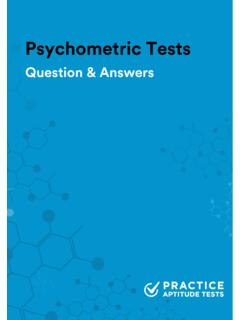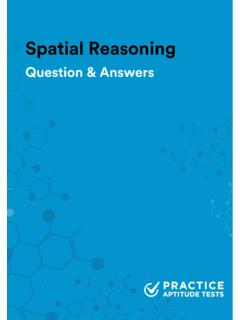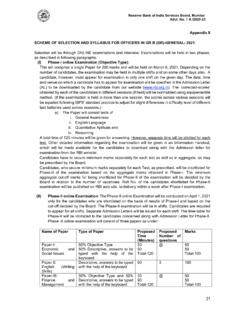Transcription of Non-verbal Reasoning
1 Non-verbal Reasoning An introduction to the tests This booklet is designed for children who are planning to take a school selection test. It explains briefly what the test is about, how different question types should be approached and how the answers should be recorded. Samples are included of some of the types of questions that children may encounter in the real tests . These questions and their explanations should be worked through gradually to establish familiarity with the nature of Non-verbal Reasoning tests and how best to deal with their challenges. A full-length practice test is provided to allow children the opportunity to sit an exam under timed conditions and to practise completing an answer sheet.
2 For parents About Non-verbal Reasoning selection tests The test is designed to assess whether grammar school is a suitable option for your child. The tests have been designed and written by experts to test those skills proven to indicate potential for academic success. They are timed tests that are sat in a formal examination environment on a set date and consist of a series of multiple choice questions. Children read the questions in a test booklet and complete their answers on a separate answer sheet. How to use these materials The aim of this booklet is to familiarise children with the idea of a Non-verbal Reasoning test and with the materials they will use on the day of the test.
3 Children that are comfortable with the idea of taking a timed examination and with the format will be more able to focus their energies on the questions themselves. The first part of this booklet looks at the general format of the test including instructions on how to mark answers. The next section provides some worked examples of Non-verbal Reasoning questions and it is important that your child has a good understanding of why the questions are answered in the way they are before moving on. The last part is a full-length practice test that should be taken in one sitting and timed appropriately. Answers and explanations are supplied at the end of the booklet.
4 For pupils Whenever you take a test it is important that you understand exactly what you have to do. Successful preparation for your examination doesn't just mean learning about the types of questions in the test. You also need to know the rules of the examination, how to behave, how to prepare yourself and how to correctly complete the tests so that the answers you submit are the ones you intended. You should also know what it feels like to have to do the test in a certain time and be comfortable with the idea of a test done by yourself. The materials in this pack have been designed to help you to prepare for such tests .
5 They will help you to become familiar with the kind of questions you will face, and the way you answer the questions. If you work through this booklet and try the full- length practice test, you should be thoroughly prepared for the real selection tests . We will start by looking at some of the rules of the test and then at the way you answer the questions. The later parts of this booklet look in more detail at the types of questions you might face. Page 2. Test instructions Some instructions will be spoken to you; others will be written in the test booklet. Try to remember the following: Read the instructions on the front of the test booklet Listen carefully to invigilators they are the adults who will guide you through the process of sitting the test.
6 They will give you instructions about what to do There are some points in the test at which you will be asked to stop working and not turn the page. In Non-verbal Reasoning tests , you will be given instructions and examples before each new section. Each section is timed separately. At the bottom of each page in the test booklet are instructions telling you to: Stop . Do not turn over until you are told to do so ! go on Please go on to the next page >>>. or that you have reached the end of the test. END OF Non-verbal Reasoning TEST. Test materials It is vital that you know how to submit your answers for marking.
7 This booklet gives you the opportunity to practise this. On the day, you will have two things provided: a test booklet, containing the questions, and a separate answer sheet. You will need to bring with you a pencil, a spare pencil and an eraser. Page 3. The answer sheet Only the answers you fill in on the answer sheet will be marked. The sheet is read by a special scanning machine so you need to mark it in a particular way in order for your responses to be clear. You can get an adult to check that you are doing it correctly. The top of the answer sheet will show the name of the test and some information about you, including your name and date of birth.
8 Check that your name and date of birth are correct. Tell an invigilator if you think there is a mistake If the boxes are blank, you will need to fill them out. Ask an invigilator to help. The rest of the answer sheet contains spaces for you to submit your answers. Each question has its own box containing the answer options. The question number is in the top left hand corner. For example, question 1 might look like this: 1. A. B. C. D. E. Page 4. You answer each question by putting a thin horizontal line in the rectangle next to your answer, like this (you can practise this later on in this booklet): If you make a mistake, rub it out as completely as you can and put in your new answer.
9 You must only use a pencil to mark the answer sheet. All the questions you do will be multiple choice. That means that you are given a range of answers to choose from. The answer options will be printed in the test booklet but you must submit your responses on the answer sheet. You may need to fill in answers on both sides of the answer sheet. You must make sure that you mark your answers in the right place on the answer sheet. Mark your answer in the box that has the same number as the test question. You must make sure that all your answers are recorded on the answer sheet before the end of the test. The test booklet: The test contains a number of different Non-verbal Reasoning question types.
10 You need to try to answer all of the questions. The test is divided into individual sections which are timed separately. Instructions are given before the start of each section along with an example question. You will also be asked to do some practice questions. These are not marked but help you understand the type of questions you are about to answer. You can do rough work in the booklet if you need to, or on a separate piece of paper. But remember: the test booklet won't be marked. All your answers must go on the answer sheet. Page 5. Non-verbal Reasoning tests What will I be tested on? The questions are tests of ability, not what you have learned elsewhere in school.



